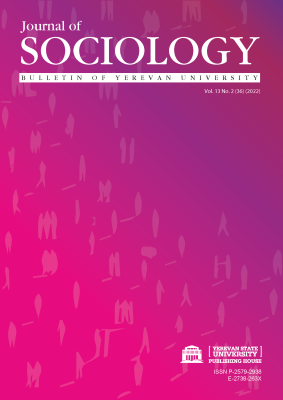Political Culture and Protest Potential in Goris Community
DOI:
https://doi.org/10.46991/BYSU:F/2022.13.2.010Keywords:
44-day Karabakh war, protest potential, political culture, Goris community, mathematical modelAbstract
SAMVEL MANUKYAN, SONA BABACKHANYAN. Political culture and protest potential on Goris community. - During the 44-day Karabakh war of 2022, Artsakh (Karabakh) and Armenia suffered serious territorial and human losses, which caused severe negative consequences. The war radically changed public sentiments in Armenia. Besides, after the war, the prices of essential goods in Armenia started to increase rapidly, gradually worsening the social condition of broad population segments. The negative consequences of the war are especially severe in the Syunik region, borders with Azerbaijan and has strategic importance for the national security of Armenia, particularly in the border community of Goris, which is the last town on the only communication road between Armenia and Artsakh. These two influential factors might initiate public protests in Goris – an area of exceptional importance for the national Security of Armenia, worsening social cohesion and destroying the social order. The article represents the evaluation of multidimensional protest potential in Goris in the context of the political culture of the community population and the situation after the war. The political culture of the Goris community is identified in the frame of the theory of S.Almond and S.Verba. The analysis is carried out on the basis of sociological survey data collected in the Goris community in April 2022. The dimensions of the protest potential include lack of loyalty to the authorities, socio-economic conditions of the population, the fact of the 44-day war, the course of the war and its consequences, and future relations with Turkey and Azerbaijan. The best-allied countries of Armenia in the Artsakh matter were revealed in population attitudes. The perception of public protest probability in Goris is estimated. A mathematical model is built to explain the interactions between protest potential and political culture components and their multidimensional impact on loyalty to the authorities.
References
Almond G., Verba S. (1992) Civic Culture and stable democracy. Polis. Political Studies, № 3-4.
Arzumanian H. V. (2019) Velvet Revolution in Armenia: Challenges and Opportunities. Izv. Saratov Univ. (N. S.), Ser. Sociology. Politology, vol. 19, iss. 2, рр. 223–230 (in Russian).
Atanesyan A., Mkrtichyan A. (2021) Armenian society at the crossroads. Foreign policy directions, priorities, and perceptions. Yerevan: Konrad Adenauer Foundation.
Caucasus Research Resource Centers “Caucasus Barometer 2010, 2012, 2013, 2019, 2021”. The database is available at https://www.crrc.am/barometer/
Cholakhyan V. (2021) International participation in the resolution of the Nagorno-Karabakh conflict in 1990–2020. Izvestiya of Saratov University. History. International Relations, vol. 21, Iss. 3, pp. 365–378. https://doi.org/10.18500/1819-4907-2021-21-3-365-378
Markedonov S. (2018) The thirty years of the Nagorno-Karabakh conflict: Basic strategies and prospects of the resolution. Post-soviet studies, v.1 №2 (2018), pp. 129-138.
Milbrath L.W. (1965) Political Participation. Chicago: Rand McNally.
Statistical Committee of the Republic of Armenia (2022). Socio-Economic Situation of RA, January-May 2022. Yerevan, Statistical Committee of the Republic of Armenia.
Zolyan S. (2001) Nagorno Karabakh: the problem and the conflict. Yerevan. “Lingua”, 2001.
Downloads
Published
How to Cite
Issue
Section
License
Copyright (c) 2022 Samvel Manukyan, Sona Babakhanyan

This work is licensed under a Creative Commons Attribution-NonCommercial 4.0 International License.








